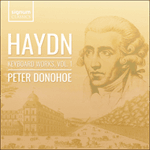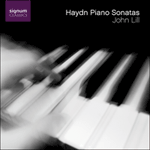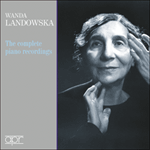
Welcome to Hyperion Records, an independent British classical label devoted to presenting high-quality recordings of music of all styles and from all periods from the twelfth century to the twenty-first.
Hyperion offers both CDs, and downloads in a number of formats. The site is also available in several languages.
Please use the dropdown buttons to set your preferred options, or use the checkbox to accept the defaults.

Despite its nonchalant opening, the sonata’s initial Allegro is a dramatic, closely wrought movement that evolves virtually all its ideas from the main theme. The far-reaching development culminates in a tense modulating passage on a four-note ‘drum’ rhythm, with extreme contrasts of register. Remarkable, too, is the expansive coda, musing first on the gentle cadential theme and then on a lyrical ‘transitional’ idea that had immediately followed the opening. The minuet finale, a free rondo with two episodes (the second in E flat minor), relaxes the tension after two such highly charged movements—though it is surely no coincidence that its first episode recalls the opening movement’s cadential theme.
from notes by Richard Wigmore © 2009
Magré son début nonchalant, l’Allegro initial est un mouvement remarquable, finement ciselé, qui tire presque toutes ses idées du thème principal. Le développement de haut vol culmine dans un passage modulant tendu sur un rythme «tambourinant» de quatre notes, avec d’extrêmes contrastes de registre. Tout aussi remarquable est l’expansive coda, qui révâsse d’abord au doux thème cadentiel puis à une idée «transitionnelle» lyrique placée juste après l’ouverture. Le finale de menuet, un rondo libre doté de deux épisodes (le second est en mi bémol mineur) relâche la tension après deux mouvements tellement chargés—encore que son premier épisode rappelle, sûrement à dessein, le thème cadentiel du mouvement inaugural.
extrait des notes rédigées par Richard Wigmore © 2009
Français: Hypérion
Trotz seines nonchalanten Anfangs ist das einleitende Allegro ein dramatischer, dicht geschmiedeter Satz, der praktisch all seine Ideen aus dem Hauptthema entwickelt. Die weit schweifende Durchführung kulminiert in einer angespannten Modulationspassage über einem viernotigen „Pauken“-Rhythmus mit extremen Registerkontrasten. Auch die ausgedehnte Coda, die zunächst über das sanft kadenzierende Thema, dann eine lyrische „Überleitungs“-Idee nachsinnt, die unmittelbar auf den Anfang folgte, ist bemerkenswert. Das Menuett-Finale in freier Rondoform mit zwei Episoden (die zweite in es-Moll) lässt nach zwei solch geladenen Sätzen die Spannung nach—obwohl es sicherlich kein Zufall ist, dass die erste Episode an das Kadenzthema des ersten Satzes erinnert.
aus dem Begleittext von Richard Wigmore © 2009
Deutsch: Renate Wendel
 Haydn: Keyboard Works, Vol. 1 Haydn: Keyboard Works, Vol. 1Peter Donohoe turns his attentions—not to mention his commanding pianism and stylistic versatility—to the keyboard works of Haydn, still somewhat neglected despite (or perhaps because of) their seminal position in the evolution of the Classical so ...» More |
 Haydn: Piano Sonatas Haydn: Piano Sonatas'For the richly experienced John Lill, Haydn's music is demonstatably of the highest quality, his quirkiness never toppling into facetiousness and oft ... 'In an age of vacuous wunderkinder, John Lill's playing stands out for its integrity and individuality … unmissable' (The Independent on Sunday)» More |
 Wanda Landowska - The complete piano recordings Wanda Landowska - The complete piano recordingsWanda Landowska (1879–1959) has achieved such fame for her 20th-century revival of the harpsichord that it is sometimes forgotten that she was a very fine pianist and continued to play music of the classical period on modern piano. This set brings ...» More |

